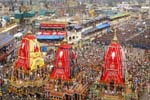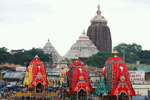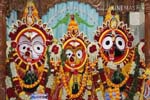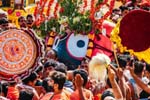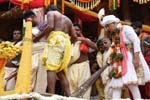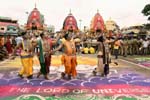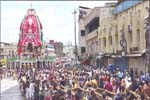
Sri Jagannath Yatra
The word ‘Jagannath’ means the lord of the universe. Lord Jagannath is a manifestation of Lord Vishnu. Puri in Odisha is one of the most sacred places for Hindus as it contains the sacred temple of Lord Jagannath. Besides, Jagannath temple also holds a place among the Chaar Dhaam pilgrimages of the Hindus.
The ‘Rath yatra’ is a 10-12 days annual celebration commemorated with colossal zest at Puri. It starts on the second day during Shukla Paksh of Ashada month. The festival marks the annual visit of Lord Jagannath to the renowned Gundicha Mata temple. Lord Jagannath’s brother and sister namely Balabhadra and Subhadra are also worshipped in the temple and they are also taken out in their respective chariots on the streets of Puri. This is a world-famous festival which attracts devotees from all over the world besides India. During the rath yatra the idols of the three deities are taken in chariots to stay in the Gundicha temple, almost three km away for nine days.
Tales related
Many tales are narrated as to this journey of the deities. According to one such tale, Gundicha was the queen of king Indradyumna, and being a true devotee of Lord Krishna, she had the temple built. It is believed that being pleased with the immense devotion of Gundicha, the Lord promised to visit her palace once a year and stay for a few days. Another legend is that Gundicha is Lord Jagannath’s aunt who loves to welcome her nephews every year and showers her affection on them.
The story of the worship of the three deities found in certain scriptures is like this –
Once, the queens of Lord Krishna in Dwarka requested mother Rohini to unfold the various ‘ras lilas’ of Krishna with the gopis. Before narrating the confidential tales of Krishna, Rohini sent Subhadra to keep a watch at the door and not let anyone come in. A little later, Krishna and Balram also came and stood on the right and left side of Subhadra. The mesmerizing narration of Krishna lila by Rohini made everyone standstill including Krishna, Balram and Subhadra.
Meanwhile Narada appeared at the scene. On witnessing the captivating sight of the three siblings together Narada requested them to grant him this divine manifestation in the same posture. His request was fulfilled and all the three divine beings manifest themselves in the same posture in the Puri temple.
Rituals
Pahadi-
The procession of the three chariots from Jagannath temple to Gundicha temple is known as ‘Pahadi’. The sizes of the chariots vary indicating the hierarchy between the three deities— Nandighosh (also called Garundhwaja or Kapildhwaja) – meaning tumultuous or blissful sound is the chariot of Lord Jagannath. It has 16 wheels with a figure of Garuna on its crest, drawn by 4 wooden horses.
Taladhwaja — meaning the sound of significantly powerful rhythm is the cart of Balram. It has 14 wheels and is drawn by 4 black wooden horses. It carries Hanuman on its crest.
Padma dhwaja or Darpdalan --- which means the destroyer of pride is the cart of Subhadra. It has a lotus on its crest with 12 wheels and is drawn by 12 red horses.
During the yatra Lord Balbhadra is brought out of the temple first followed by Devi Subhadra and finally Lord Jagannath.
Chhera Pahara –
This ritual envisages that everyone is equal in the eyes of God. In this ritual the Gajapati king wears the form of a sweeper and cleans the area around the deities and their chariots with a gold handed broom with immense devotion. The ritual is performed twice- at the beginning of their journey to Gundicha temple and then on their arrival back to the temple.
Bahuda Yatra –
The return journey of the deities is known as Bahuda Yatra. On their way back, the chariot of Jagannath stops at Ardhasini temple. Here Lord accepts his favorite rice cake (poha pitha) from his aunt, the presiding deity of the temple. The deities reach the temple by Ekadashi day and then are attired in new costumes. The following day the deities move into the sanctum sanctorum (garbh griha) of the temple. And the rath yatra comes to an end.
Spiritual significance
It is believed that participating in this rath yatra with full devotion will make a person free from the cycle of birth and death. Even a glimpse of Lord Jagannath on his chariot is considered very auspicious. These chariots are designed from a special kind of wood obtained from trees which bear specific markings as prescribed by the scriptures. The idols of the three deities are also made of wood and are replaced every 12 years.
The significance of the rath yatra lies in the belief that it paves the way to final liberation. Devotees believe that anyone who pulls the rope of the chariots earns the merit of several penances. Saints, poets and scriptures have repeatedly glorified the importance of this special festival. The level of sanctity is such that a mere touch of the chariot or the ropes tied with it is enough to confer the result equal to several pious deeds. On this occasion the chariot, wheels, the grand avenue all become one with the deity Himself. All people, irrespective of religion, caste, etc can take part in the procession.
Mention in Puranas --
The Skanda Puran glorifies the sanctity of rath yatra in these words—
‘Gundicha mandapam naman Yatraharnajanam pura Ashwamedha sahasrasya mahabedi tadadvabat’
Meaning that those who are fortunate to see the procession of the deities from Srimandira to Gundicha temple attain the benefits of a thousand horse sacrifices.
The spiritual significance of rath yatra is profusely explained in Kathopanishad in following words-
‘Atmanam rathinam viddhi sareeram rathamevatu Buddhim tu saarthim viddhi marah pragarbhameva cha’
Meaning that the body is the chariot and the soul is the deity installed in the chariot. The wisdom acts as charioteer to control the mind and the thoughts. It can be further explained that the senses are the horses, and the yatra is the bhavasagar (material existence).
Thousands of devotees gather for the purpose of remembering God. It is mentioned in the scriptures by Lord Krishna to Narada that you will find me wherever my devotees come together to remember me. Jagannath is the lord of the universe. Vedanta sutra states “Janmadya asya yatah” that the absolute truth is one from whom everything emanates. We often forget this origin of the universe but the true and unconditional love for the lord is dormant in the hearts of all living beings, which can be awakened by chanting the holy name of the lord.
The meaning of rath yatra is beautifully explained by Srila Praphupad. He says that God resides in every one’s heart but we have forgotten him. Rath Yatra is symbolic of bringing Him back into our hearts. To make our hearts a suitable living place for Him it must be cleaned. If our hearts are accumulated with the dirt of envy, greed, arrogance, anger etc. He will refuse to live in it. So the real purpose of spiritual life is to make our hearts a suitable place for God.
Therefore the significance of rath yatra is immense for the one who longs for spiritual merit and final liberation.
Author Ms Hema Trivedi is an ardent devotee of SriKrishna
